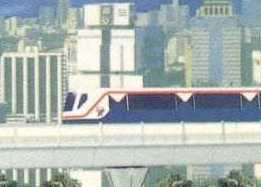![]()
![]()
Q:
When
will the skytrain start operation and on which route?
A:
The skytrain will start operation of the Silom line in the beginning of
December 1999 since the Silom line is shorter (6.5 km). There will be 7
stations starting from Sathorn tothe National Stadium

Q:
After the opening of the first phase, when will other sections be open
to the public?
A:
The
Sukhumvit line statrting from Sukhumvit 81 and endingat the Mor chit BusTerminal
for a total of 17 stations. The Sukhumvit line will open around the beginning
of 2000 because it is longer than the Silom line.
Q:
Would there be anything that could cause delay of the opening?
A:
The
government might delay the opening as they did in the case of BECL.But
there are no problems as for the construction. All construction will be
finished by 1999.
Q:
What would be the fare?
A:
The
fare collection was agreed at 15 baht. But due to thailand's economic state,
a proposal by BTS to raise the train fares has been issued to the government
to collect the fares by distance of travel. However, the
government
has yet to act on the proposal and it is unkown how long until the issue
will be dealt with.
Q:
Certain people are worried about the amount of pollution the trains would
cause. Some, like Mater Dei School went as far as protests. Does their
fear have ground? What would the amount of pollution be?
A:
The train itself will not cause any environmental problems since it uses
electricity for driving. The structure of the stations ; noise and dust
will not be all that different from the present condition. There may be
the problem of Carbonmonoxide but that is mostly because of the automobiles
on the roads. As for the Mater dei station, they have solved the problem
by moving the location of the stairs so that it is further away from the
school.
This will help to lessen the crowd of people who will come to use the train.
Also, they have put up more sound proof walls around the station.
Q:
What would the trains be like? Is it possible to give the technical details
of the train?
A:
The
trains will be powered by electric motors fed by an electrified third rail.
The system will incorporate a signalling system that continuosly advises
the train drivers of the optimum driving conditions including
speed,
braking, when to shut doors etc. Built-in automatic protection systems
will ensure that no unsafe situation can arise.
The
trains can carry up to 50,000 people/hour/direction. The system will use
only three-car trains on the commencement of the operation, and six-car
trains will be used when passenger usage of the system rises to beyond
the level where the tree-car trains can accomodate the peak hour passenger
flow.
1 car can carry about 320 passengers. It can be driven manually or by computer
but the safety systems are controlled by computers only. The BTS skytrain
has been proved to cause no environmental hazards. For
example,
to prevent noise pollution, they use resilent wheels (a rubber padding
around the wheels that will help absorb the tremours and noise), electric
motors and brakes etc.
Q:
In the long run, when will the trains have to be replaced? Would it become
louder and dirtier when they are old?
A:
The skytrain will open from 6:00-24:00. After that, they will go into the
depot for maintainance and system checks.
Q:
Most people would like to know about the services such as ticket sales,
assistance at stations and on the train.
A:
An automatic fare collecting system (ticket issuing machine) providing
single ride and store value tickets will be used. During the first period
of opening, there will be assistants to help guide you through the process.
Also there will be security guards at every station 24 hours a day.
Q:
If electricity fails, would the trains be stuck on the elevated rails?
How would the passengers get out?
A:
There are two substations, one at Mor Chit and one at Phai Singhto. If
the electricity fails in one station, the other station is able to send
electricity and restore all systems.
If
there is a need to move passengers out, another train will come to pick
up the passengers and send them to the next station.
Q:
Does BTS plan to suppliment the future underground mass transit system
or do Does it plan to compete with it?
A:
The BTS and the underground mass transit system are linked together at
3 locations. The first location is Rama 4 (Saladaeng junction). The second
is Asok road. The third is the Phahonyothin road (around the front of Jhatujhak
Market).

![]()